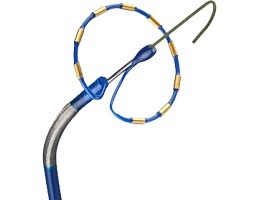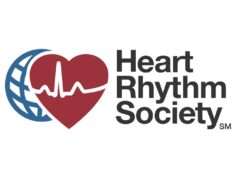 Phased radiofrequency (RF) ablation using the PVAC GOLD catheter for pulmonary vein isolation in paroxysmal and persistent atrial fibrillation (AF) has demonstrated good outcomes for quality of life and 12-month efficacy. Results from the multicentre GOLD-AF registry were presented by Lucas VA Boersma (St Antonius Hospital, Amsterdam UMC, The Netherlands) in a late-breaking trial session at the European Heart Rhythm Association (EHRA 2019; 17–19 March) congress in Lisbon, Portugal.
Phased radiofrequency (RF) ablation using the PVAC GOLD catheter for pulmonary vein isolation in paroxysmal and persistent atrial fibrillation (AF) has demonstrated good outcomes for quality of life and 12-month efficacy. Results from the multicentre GOLD-AF registry were presented by Lucas VA Boersma (St Antonius Hospital, Amsterdam UMC, The Netherlands) in a late-breaking trial session at the European Heart Rhythm Association (EHRA 2019; 17–19 March) congress in Lisbon, Portugal.
Boersma said: “The GOLD-AF registry provides information about population, indications and outcomes using a second-generation phased RF system in >1000 patients. It appears to be effective at 12 months, with 77.7% freedom from AF recurrence. Phased RF procedure time was predictable and relatively short compared to the literature, with a low complication rate, no oesophageal fistula and a very low stroke rate. Many patients—70% of patients—showed a big change in symptoms after the procedure.”
The GOLD-AF registry was a prospective, multicentre, observational and longitudinal study at 40 sites in 14 countries in Europe and Asia. The population consisted of patients with AF ≥18 years old; it included subjects with persistent AF, paroxysmal AF, and long standing persistent AF, and they had to be treated with phased RFA. The primary objective of the trial was freedom from AF recurrence between three and 12 months after the ablation procedure. Failure was defined as cardioversion, a re-ablation, >30 seconds of AF, or ≤30 secs of AF with symptoms. Clinical follow-up and arrhythmia monitoring was performed as per standard of care in each centre. Symptoms and quality of life (QoL) were assessed at 12 months.
Boersma explained: “The phased RF ablation system has been around since 2005; it was one of the first successful single shot technologies, just as the cryoballoon has been very successful in the last 15 years. Phasing means that when the RF energy is unipolar on adjacent electrodes … that there is only RF energy going into the tissue between the electrode and the back patch, and then there is also a phase where the adjacent electrodes have bipolar energy where the current flow is actually going between electrodes, which fills the gap between adjacent electrodes, and this is considered to be an effective way to get nice long continuous lesions.”
In all, 1071 consecutive patients with AF scheduled for phased RFA procedure were enrolled in the registry; 1,054 had a baseline analysis, with follow-up analysis on 943 patients who had a valid 12 month follow-up form (329 from a follow-up site visit and 614 from a follow-up phone call for the quality of life analysis).
Boersma described the patient characteristics as “pretty typical”—age 60 years, 67.5% were male, with an average left atrial (LA) volume of 49ml and LA diameter of 42mm. Indications for phased RF ablation were for paroxysmal AF in 70% of patients, and persistent AF in 26% of patients, with about 3% having long standing persistent AF; most of the participants (95%) were symptomatic. Obesity was present in 27%, hypertension in 53%, and the mean CHA2DS2VASc score was 1.8±1.4, “which reflects that these were fairly healthy patients”, Boersma pointed out. For most of the subjects it was an index procedure (94.3%).
Procedure time was 107 minutes, “very similar to what we see in the other registries and trials”, according to Boersma. The procedure was considered a success by investigators in 96% (1013/1054) of cases, and in 94% (977/1036) of subjects, pulmonary vein (PV) isolation was confirmed (assessed by exit/entrance block in all PVs).
In regards to outcome data on safety at ≤30 days, procedure-related events occurred in 26/1054. Boersma said: “Overall, we have adverse events in 2.5% of the patients. Most of them were access site complications, 1.7% [n=18]. There was a very low rate of ischaemic stroke or TIA [transient ischaemic attack], 0.3%. There were only two pericardial effusions [0.2%], and there was one late phrenic nerve injury [0.1%].”
There were no oesophageal fistulae, and no deaths. Freedom from AF recurrence at 12 month follow-up was 77.7%, and mean time to recurrence was 185 days. Atrial flutter was reported in 0.4% of patients, and atrial tachycardia in 0.2%.
Boersma described the analysis on quality of life measures as “very important, because that is what affects people in their daily life”. Investigators examined the improvement in AFEQT (Atrial Fibrillation Effect on Quality of Life) score between baseline and 12 months, with follow-up assessed by a phone call (n=459) or an office visit (n=199). An increase in score ≥19 was considered a meaningful improvement. Overall, the score improved by 38 for those assessed by a phone call at 12 months, and by 33 for those assessed by an office visit. Individual measures for daily activities, symptoms, treatment concern and treatment satisfaction also showed a meaningful improvement at 12 months for both phone and office follow-up (p<0.0001).
Patients with a recurrence of AF also showed a significant increase in AFEQT score between baseline and 12-month follow-up (29), although this was not as large as that seen for patients without AF recurrence (38). Average symptom improvement based on the EHRA (European Heart Rhythm Association symptom classification for atrial fibrillation) score showed a change from 2.3 at baseline to 1.5 at 12 months, with 68% of patients demonstrating improvement. And a symptom severity score also showed improvements for palpitations, syncope, dizziness, irregular heartbeats, shortness of breath, and fatigue between baseline and 12 months.









